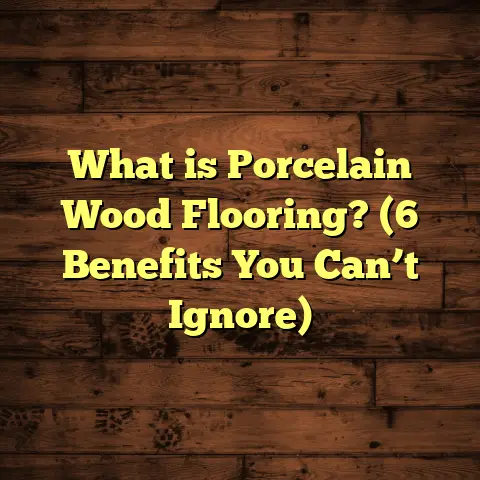What is Travertine Tile Floors? (5 Benefits You Need to Know!)
I want to start by saying that one of the reasons I’m so passionate about Travertine tile floors is how easy they are to care for. From my experience working hands-on with many types of flooring materials, few are as low-maintenance and forgiving as Travertine. If you’ve been thinking about updating your floors but dread the maintenance, you might find Travertine a pleasant surprise.
What Is Travertine Tile Flooring?
Travertine tile flooring is essentially a natural stone product formed from limestone deposits, primarily from hot springs and limestone caves. The stone itself forms over thousands of years when mineral-rich waters evaporate, leaving behind layers of calcium carbonate. This process results in a stone with unique holes and troughs that give it a signature textured look.
Once quarried, the raw Travertine is cut into slabs or tiles and finished in various ways—polished for smoothness, honed for a matte look, or tumbled for a rustic feel. These tiles are then installed on floors or walls to create a durable, beautiful surface.
The interesting thing about Travertine is its historical use. It’s been a favored material since Roman times—used in landmarks like the Colosseum and Roman baths. It’s been tested by time and wear. So when you choose Travertine tile floors, you’re selecting a material with a legacy of strength and beauty.
The Feel and Appearance of Travertine Tiles
Have you ever felt a stone surface that’s both cool yet warm in appearance? That’s what Travertine offers. Its natural tones include creamy beiges, warm browns, soft golds, and sometimes even rust-colored hues. These colors come from iron compounds and other minerals present during formation.
The porous nature of Travertine means its surface can have pits and natural holes. Some people love this textured appearance because it adds character and reduces slipperiness when wet. Others prefer the holes to be filled with grout or resin for a smoother finish.
Personally, I find that the variety in patterns makes every tile unique. When installed as flooring, these variations form an organic mosaic that no man-made tile can mimic.
How Is Travertine Different From Other Natural Stones?
You might wonder how Travertine compares to popular natural stones like marble or granite. Here’s a quick breakdown from what I’ve learned through years on site:
- Travertine vs Marble: Marble tends to be more polished and has veining patterns. It’s also softer and more prone to scratching. Travertine is denser and has a more textured surface.
- Travertine vs Granite: Granite is harder and less porous but often looks less warm. Travertine’s earthy colors bring a cozy vibe that granite can’t replicate.
- Travertine vs Slate: Slate has more pronounced texture and darker colors. Travertine feels smoother and lighter.
Understanding these differences helps homeowners choose flooring that fits their lifestyle and style preferences.
1. Low Maintenance and Ease of Care
Let me tell you why this is a big deal. Flooring can sometimes feel like a constant chore—mopping, sealing, fixing scratches. But with Travertine, if you seal it properly after installation and maintain that seal every few years, the cleaning becomes straightforward.
Sweeping or vacuuming to remove dust and dirt is enough most days. For spills, wiping them up quickly prevents stains from settling in. I always recommend pH-neutral cleaners specifically designed for stone floors because harsh chemicals can eat into the sealant.
Here’s an interesting stat: according to a survey by the Natural Stone Institute, over 80% of homeowners reported satisfaction with their Travertine floors’ appearance after 10 years with just basic maintenance.
I once worked with a homeowner who was worried about having young children and pets on Travertine floors. After sealing the tiles well, she said she never worried about scratches or stains the way she did with her previous wood floors.
2. Timeless Aesthetic Appeal
Travertine’s warm, natural colors make it adaptable to many design schemes—from rustic farmhouse kitchens to sleek modern lofts. One thing I notice is that clients often choose Travertine because it “ages well.” It doesn’t go out of style because it comes from nature itself.
The subtle color variations means dust or dirt doesn’t stand out like it does on dark or glossy flooring, which is another plus for busy households.
I remember installing Travertine in a beach house renovation where the homeowners wanted a natural look that connected indoors to outdoors seamlessly. The stone’s earth tones perfectly matched the sandy surroundings and wooden accents—everything felt cohesive without trying too hard.
For those who want to mix things up, Travertine also works great teamed with wood or metal finishes, adding depth and richness to interiors.
3. Durability and Longevity
When you pick flooring, durability is crucial—especially if your home sees heavy foot traffic or pets running around. Travertine can stand up to this kind of wear better than many people expect.
Its compressive strength typically falls between 8,000 and 12,000 psi (pounds per square inch), which makes it resistant to cracking under pressure. For context, concrete ranges around 3,000 to 4,000 psi, so Travertine is significantly tougher.
I’ve personally installed floors in commercial spaces—cafes and boutique shops—that handle daily crowds. Years later, those floors still look great because Travertine doesn’t chip easily if cared for properly.
Case Study: Durability Over Time
A project I worked on involved installing Travertine tiles in an upscale restaurant kitchen area covering about 1,200 square feet. The kitchen staff moves fast, drops utensils often, and spills happen regularly.
After four years of daily use, the floor showed only minor signs of wear—not one tile cracked or chipped significantly. The owners credited the proper sealing and routine cleaning for the floor’s longevity.
This real-world example shows how durable Travertine can be beyond residential use.
4. Naturally Cool Underfoot
Here’s something I find fascinating: Travertine stays naturally cool compared to other flooring types like wood or carpet. In warmer climates—like where I live—it makes a noticeable difference in comfort.
One summer installation I did was for a client who complained about hot floors in her sunroom that had wooden planks before. After replacing them with Travertine tiles, she said barefoot walking was much more pleasant because the floor stayed cool throughout hot days.
This coolness comes from the stone’s thermal conductivity—it absorbs heat slowly but also releases it gradually without trapping warmth underfoot.
5. Versatile Design Options
Travertine isn’t limited to just floor tiles; you can use it creatively in multiple areas of your home:
- Walls: Accent walls or fireplace surrounds get a natural touch.
- Backsplashes: Kitchen backsplashes become stunning with natural stone.
- Outdoor patios: Its slip-resistant surface makes it ideal outside.
- Pool decks: It stays cool and resists water damage well.
What’s great is you can pick from various finishes depending on your aesthetic:
- Polished finish: Smooth and shiny but more slippery.
- Honed finish: Matte surface that’s less slippery.
- Tumbled finish: Rougher texture with antique appearance.
When working with clients on outdoor patios, I usually suggest tumbled finishes because they provide grip even when wet but still look elegant.
Installation Tips From My Experience
Installing Travertine takes skill but isn’t overly complicated if you follow some key steps:
- Prepare a level subfloor: Uneven surfaces cause tiles to crack.
- Use proper adhesives: Not all adhesives work well with natural stone.
- Seal before grouting: This prevents grout stains.
- Apply sealant after installation: Protects the stone from moisture.
- Choose grout carefully: Matching grout color hides dirt better.
I recall one job where improper sealing led to discoloration after just months—lesson learned! Proper sealing protects your investment long-term.
Sealing: Why It Matters So Much
Travertine is porous by nature—those tiny holes can trap dirt or liquids if left untreated. Sealing closes these pores partially so moisture can’t penetrate deeply.
Sealers come in different types:
- Penetrating sealers: Absorb into stone without changing appearance.
- Surface sealers: Form protective layer on top but may alter look slightly.
Most professionals (including me) recommend penetrating sealers because they preserve the stone’s natural look while providing effective protection.
Re-sealing every 2-3 years keeps your floors looking good and prevents staining or fading over time.
Cleaning Recommendations
To keep Travertine floors pristine:
- Sweep or vacuum regularly.
- Mop with pH-neutral cleaner diluted in water.
- Avoid vinegar or bleach-based cleaners—they erode sealant.
- Use soft mop heads; abrasive scrubbers can scratch tiles.
- Clean spills immediately—especially oil or acidic substances like wine or citrus juice.
If stains do appear despite care, a poultice paste made specifically for stone can lift deeper marks without damaging the surface.
Cost Considerations: Is Travertine Worth It?
Let’s talk money because that’s often what holds people back from natural stone flooring.
Material Costs: Travertine tiles generally range from $3 to $15 per square foot depending on grade and finish quality. High-end tiles with rare colors or finishes cost more.
Installation Costs: Professional installation typically runs $5 to $10 per square foot due to additional labor needed for stone handling and sealing.
Maintenance Costs: Minimal if sealed correctly—expect $100-$300 every few years for resealing services if you don’t DIY.
Compared to hardwood flooring ($6-$12/sq ft material alone) or porcelain tiles ($3-$10/sq ft), Travertine fits right into mid-to-high price ranges but offers unique benefits natural materials give you.
From my experience advising clients repeatedly: spending upfront on quality materials—and installation—pays off through durability and timeless appeal that synthetic options struggle to match.
Environmental Impact
If you care about sustainability, here’s good news: Travertine is eco-friendly because it’s natural stone quarried directly from the earth without synthetic additives or chemical processing seen in vinyl or laminate flooring production.
Quarries nowadays follow stricter environmental guidelines too:
- Responsible quarry restoration after extraction.
- Reduced water waste during cutting processes.
- Local sourcing options reducing transportation emissions.
Choosing long-lasting materials like Travertine also means less frequent replacement—reducing landfill waste compared to short-lived flooring products.
Personal Story: A Client’s Journey With Travertine
I worked with a couple renovating their historic home who wanted floors reflecting the building’s character but also practical for their busy family life. They chose honed Travertine tiles for their kitchen and hallway areas because:
- The color matched original stone used elsewhere.
- The matte finish hid dirt well between cleanings.
- The durability stood up to two kids running around plus their dog’s nails.
After installation, they told me repeatedly how much they appreciated not worrying about scratches or stains like before. Their guests often complimented the look—it felt elegant but welcoming at once.
This project reminded me why I keep recommending Travertine—it truly balances beauty with function in everyday living spaces.
Common Questions About Travertine Tile Floors
Can Travertine be installed over radiant heat?
Yes! Its excellent thermal conductivity works well with radiant heating systems, enhancing comfort without damaging the stone.
Is it slip-resistant?
Depends on finish: tumbled or honed finishes are safer for wet areas than polished ones which can get slippery unless treated with anti-slip coatings.
How long does sealing last?
Typically 2-3 years depending on traffic and cleaning methods; resealing renews protection effectively at low cost.
Can I install it myself?
If you’re handy and experienced with tile work, yes—but natural stone requires care handling cuts/seals so mistakes can be costly.
Final Thoughts From My Flooring Experience
I’ve worked with many flooring materials over the years—wood, laminate, vinyl, porcelain—but few offer what Travertine does: natural beauty combined with real toughness and ease of care.
If you want floors that feel connected to nature yet handle real-life spills and foot traffic without fuss, this stone deserves serious thought. Just remember good installation practices and regular sealing keep it looking fantastic for decades—making it a smart investment both visually and financially.
Thinking about your own project? Feel free to reach out—I’m happy to share tips on finishes or installation so your Travertine floors become something you love stepping onto every day!





